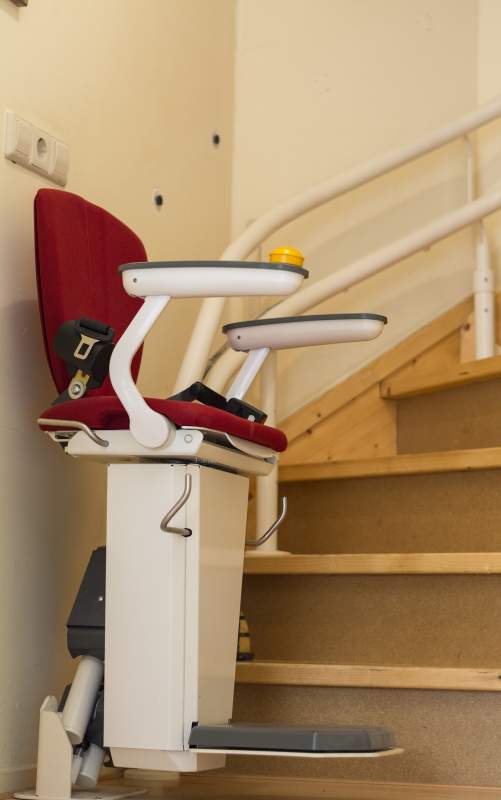A lot of people are looking for information on how to retirement proof a two story house. That’s because aging in place has become more popular recently. According to a research report by AARP, 90% of elderly people want to stay in their homes as they age.
It’s not surprising because aging in place has been found to promote self-esteem, happiness, and a positive attitude towards life. It allows you to live the rest of your life in a home you’ve always loved and to be close to your loved ones who truly care about you. Moreover, you can maintain life-long friendships and community ties when you stay where you are.
If aging in place is something that you’ve been considering, you need to prepare your home for your retirement years.
How to Retirement Proof a Two Story House? Here’s a Solution…
When we talk about aging in place or making a home retirement proof, one of the things that immediately comes to mind is Universal Design. The aim of Universal Design is to create spaces that are comfortable and safe for people of all ages. It creates an aesthetically pleasing environment that allows ease of movement even with everyone’s changing needs and abilities.
The 7 principles of Universal Design were developed by a group of architects, product designers, engineers, and researchers in North Carolina State University. These principles are meant to guide the design of products and environments, including living spaces:
Principle 1: Equitable Use
The design is useful and marketable to people with diverse abilities.
Example: A no-step entrance that allows everyone, including those in wheelchairs, to enter a home safely and without any difficulty.
Principle 2: Flexibility in Use
The design accommodates a wide range of individual preferences and abilities.
Example: A cupboard with an adjustable height.
Principle 3: Simple and Intuitive Use
The use of the design is easy to understand, regardless of the user’s experience, knowledge, language skills, or current concentration level.
Example: Control buttons on household appliances marked with easy-to-understand symbols and text.
Principle 4: Perceptible Information
The design communicates necessary information effectively to the user, regardless of ambient conditions or the user’s sensory abilities.
Example: Contrasting colors of stair edges and entry steps to help prevent tripping.
Principle 5: Tolerance for Error
The design minimizes hazards and the adverse consequences of accidental or unintended actions.
Example: A cushioning layer like SmartCells that goes underneath sheet vinyl and carpet tiles to reduce the force of impact on the body in case of a fall.
Principle 6: Low Physical Effort
The design can be used efficiently and comfortably and with a minimum of fatigue.
Example: Using levers instead of knobs as door openers.
Principle 7: Size and Space for Approach and Use
Appropriate size and space is provided for approach, reach, manipulation, and use regardless of the user’s body size, posture, or mobility.
Example: Wide doorways that allow wheelchair-bound people to enter an area easily.
Universal Design Features to Consider to Retirement-Proof Your Home

Here are some universal design features you might want to include to make your two-story house safe and livable as you age:
- A master bedroom on the ground level
- Comfort-level toilets
- Multi-level kitchen countertops that allow you to work while seated
- Non-slip floors and bathtubs
- Windows that are easy to open
- Raised front-loading washing machines and dryers
- Cabinet pulls that are easy to grip
- Reachable electrical switches and controls
Retirement Proof a Two Story House By Making the Stairs Safer
 The stairs should be one of the first things to consider when you’re thinking about how to retirement proof a two story house. Stairs can be hazardous. According to a report by Reuters, about 1 million Americans injure themselves on the stairs per year. That’s one injury every 30 seconds!
The stairs should be one of the first things to consider when you’re thinking about how to retirement proof a two story house. Stairs can be hazardous. According to a report by Reuters, about 1 million Americans injure themselves on the stairs per year. That’s one injury every 30 seconds!
As you grow older, navigating the stairs becomes more and more challenging. But you can prevent serious injuries by following these tips to make the stairs in your home significantly safer:
-
Illuminate the whole staircase, especially the top and bottom steps, where most falls occur.
It should be easy to see where you place your foot with every step you take.
-
Ensure that the individual steps are easy to distinguish.
As you grow older, depth perception becomes more difficult, so there has to be visual separation between steps. Demarcate the edges. Also, use a contrasting color for the vertical portion of the steps to help you see which part of the step is meant to be stepped on.
-
Make the vertical and horizontal surfaces of the stairs uniform.
See to it that the depth and height of the steps are consistent. This will go a long way to prevent tripping.
-
Ensure that the steps aren’t slippery.
You can use rubber or abrasive stair treads. Other solutions are anti-slip tape and skid-resistant floor treatments.
-
Avoid the “bottom-of-flight illusion” like the plague.
The bottom-of-flight illusion is when the lowest step blends in with the landing rather than the rest of the staircase. The illusion tricks your eyes into believing that you’re stepping on a flat landing and puts you in danger of tripping. To prevent this, make sure that the bottom step matches with the rest of the steps. Alternatively, you can mark it with an anti-slip tape or rubber tread.
-
Make your handrails safe.
A round handrail is the safest option, especially when your hand can completely encircle it. Additionally, it would be a good idea to install rails on both sides of the stairs as this will help you when you have balance issues or if you favor one side more than the other.
-
Make room for a stair lift
You don’t know how difficult it may be for you to navigate the stairs when you get older, so make sure that you’ll be able to install a stair lift should the need arise. The stairway must be wide enough to accommodate the seat and allow people to pass through the stairs with the seat in place.
Conclusion
If you want to retirement-proof your home, the Universal Design principles will prove to be essential. You need to work with a contractor that understands these principles, like Winthorpe. We believe the aging-in-place design-build model is a great approach to design and remodeling. Schedule a free in-home consultation with us and we’ll find the best aging-in-place solutions for you.





